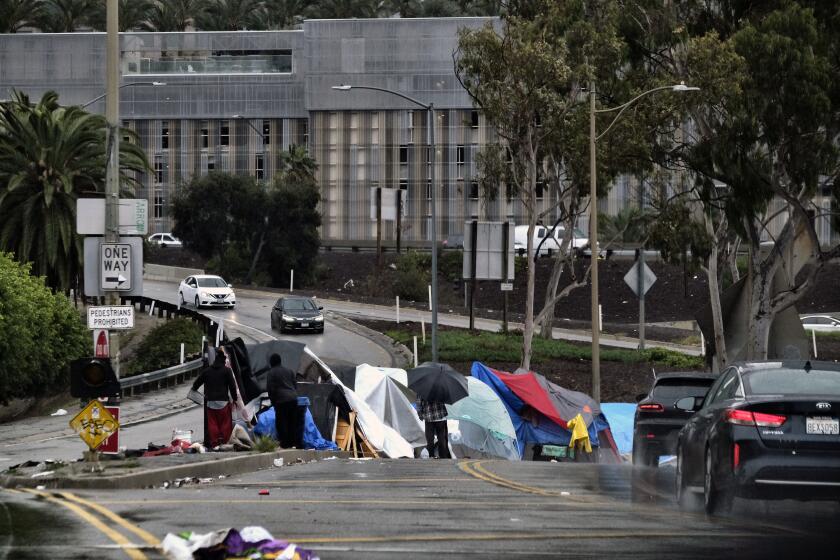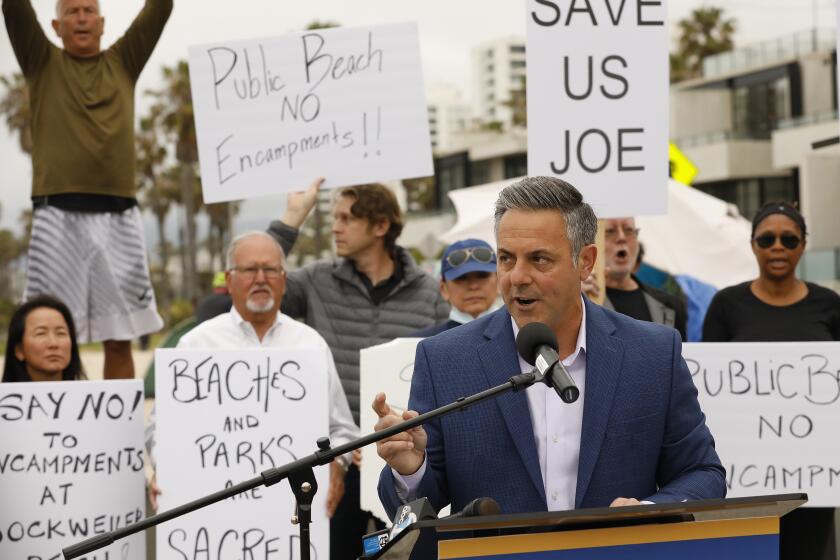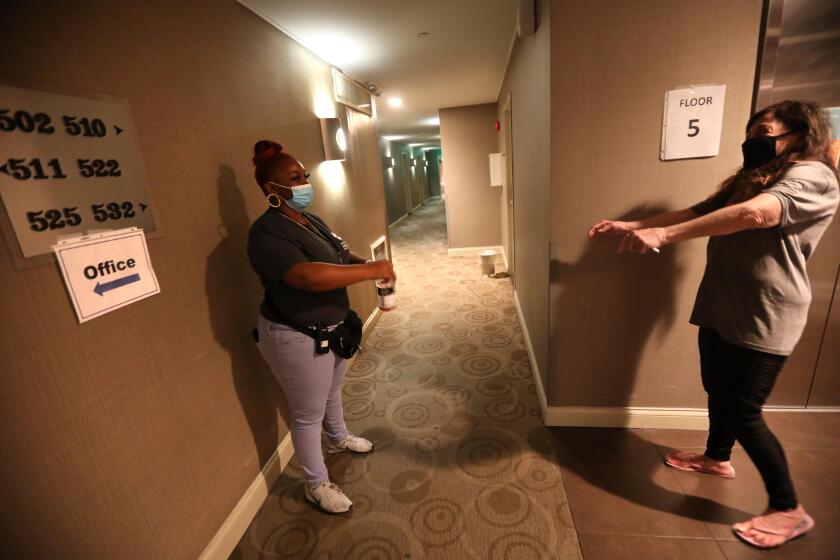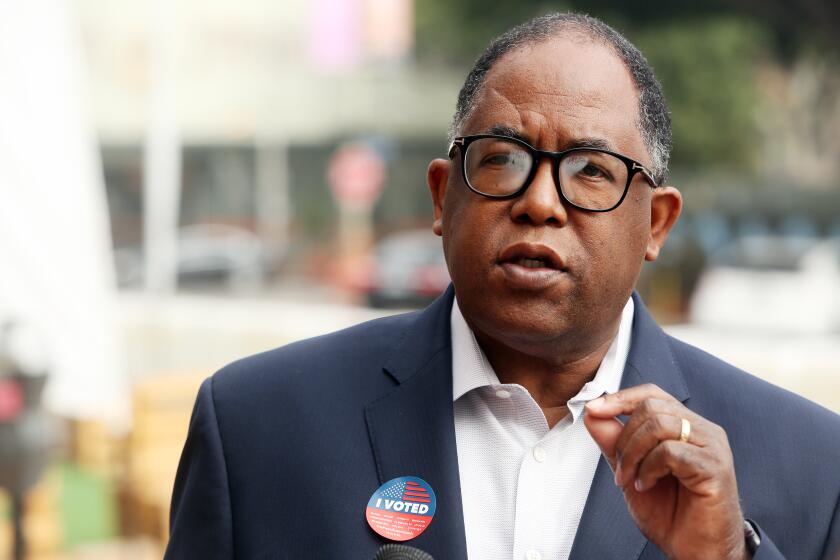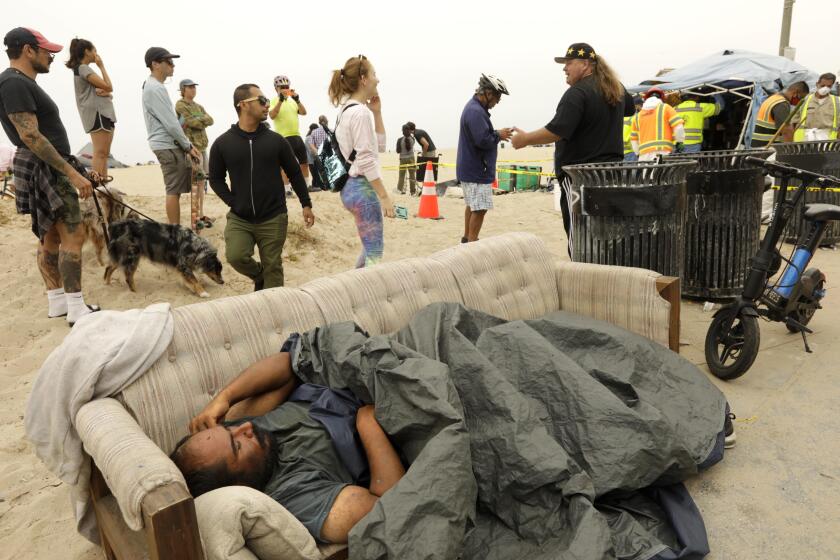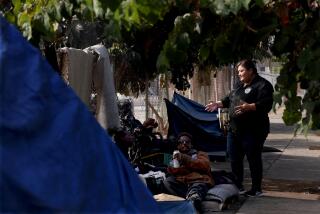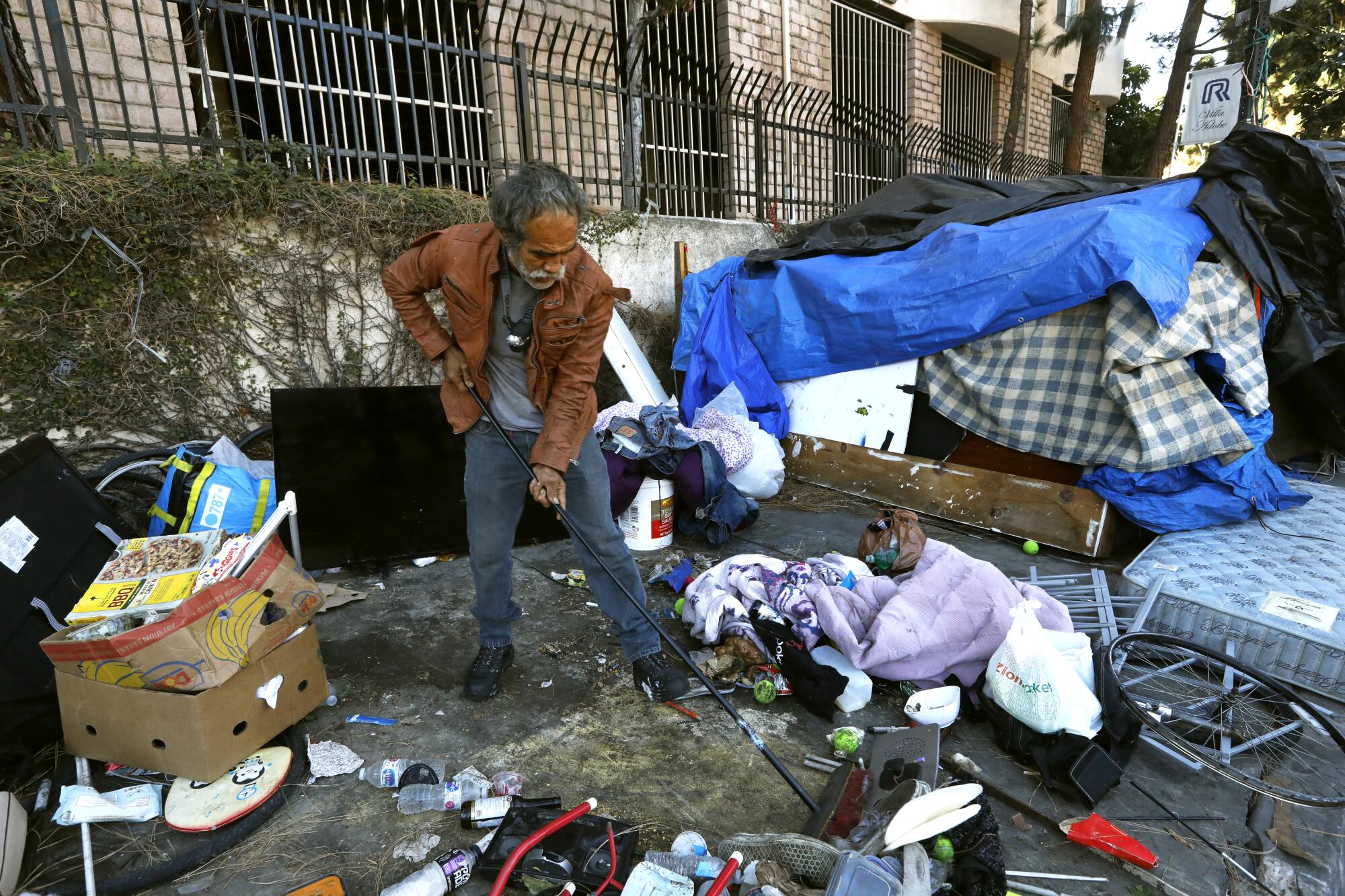
- Share via
The city of Los Angeles has undertaken a major shift in its approach to homelessness, one that puts a priority on clearing unsightly street encampments even when insufficient permanent housing exists for the people being moved.
In the last month, City Council members have identified nearly 300 locations where they would like to ban camping under a new law that was passed in August.
For the record:
3:06 p.m. Nov. 8, 2021An earlier version of this article contained an incorrect reference to the St. Joseph Center as St. Vincent’s.
2:30 p.m. Nov. 3, 2021A previous version of this article described Shayla Myers of the Legal Aid Foundation of Los Angeles as an intervenor in a lawsuit. She represents an intervenor.
There is widespread agreement that the street encampments, which have spread from skid row to almost all parts of the city, are unsafe, unsanitary and inhumane, reflecting a profound societal failure. But there is also a concern that the change in policy elevates politics over need, creating a squeaky-wheel strategy of clearing those street encampments that have become the biggest liabilities to members of the City Council.
It’s “just shuffling people all around from location to location, based on constituent complaints and the political whims of the City Council members,” said Shayla Myers, a senior attorney with the Legal Aid Foundation of Los Angeles. “The reality is: Many, many people who are in interim housing fall back onto the streets rather than moving into permanent housing through no fault of their own. There simply is not enough permanent housing available.”
But the new course has gained qualified approval from some homeless services providers, who see advantages as long as adequate shelter and services are provided. People are better off in shelters than on the street, they say, and removing whole encampments avoids the dislocation people can experience when they are plucked from street communities to go to an apartment.
The most formal embrace of the policy shift came over the last month, as the council, using the new law, designated 77 sites around L.A. as off-limits to homeless camping. Nine locations were approved Tuesday five on Wednesday and six more on Friday. About 200 more are coming up for council approval in the coming days and weeks.
The Los Angeles City Council approved a ban on camping at certain locations in the first use of a new set of laws that passed over the summer.
Councilman Joe Buscaino leapfrogged all his colleagues last week by proposing 161 locations in addition to his initial list of 11, an escalation that underlined the political dimensions behind the strategy. Buscaino, who is running for mayor on a platform of clearing encampments, has railed at the cumbersome, bureaucratic process the city created over the summer, and called for even stricter rules that that would prohibit people from sleeping or camping in public if they have turned down offers of shelter or emergency housing.
“It is now my intention to ensure that these areas remain clean and safe, and are not repopulated by new encampments,” Buscaino said.
The city’s new strategy represents a fundamental change of direction after years in which scarce housing for homeless people was parceled out through a system designed to provide housing to those with the greatest need first.
The approved motions authorize the city to post signs notifying people camped in the designated locations that they have 14 days to leave. Outreach workers will offer shelter beds to everyone affected to keep the city in compliance with a federal court ruling that prohibits the ticketing or arrest of anyone for camping in a public space when no shelter is available.
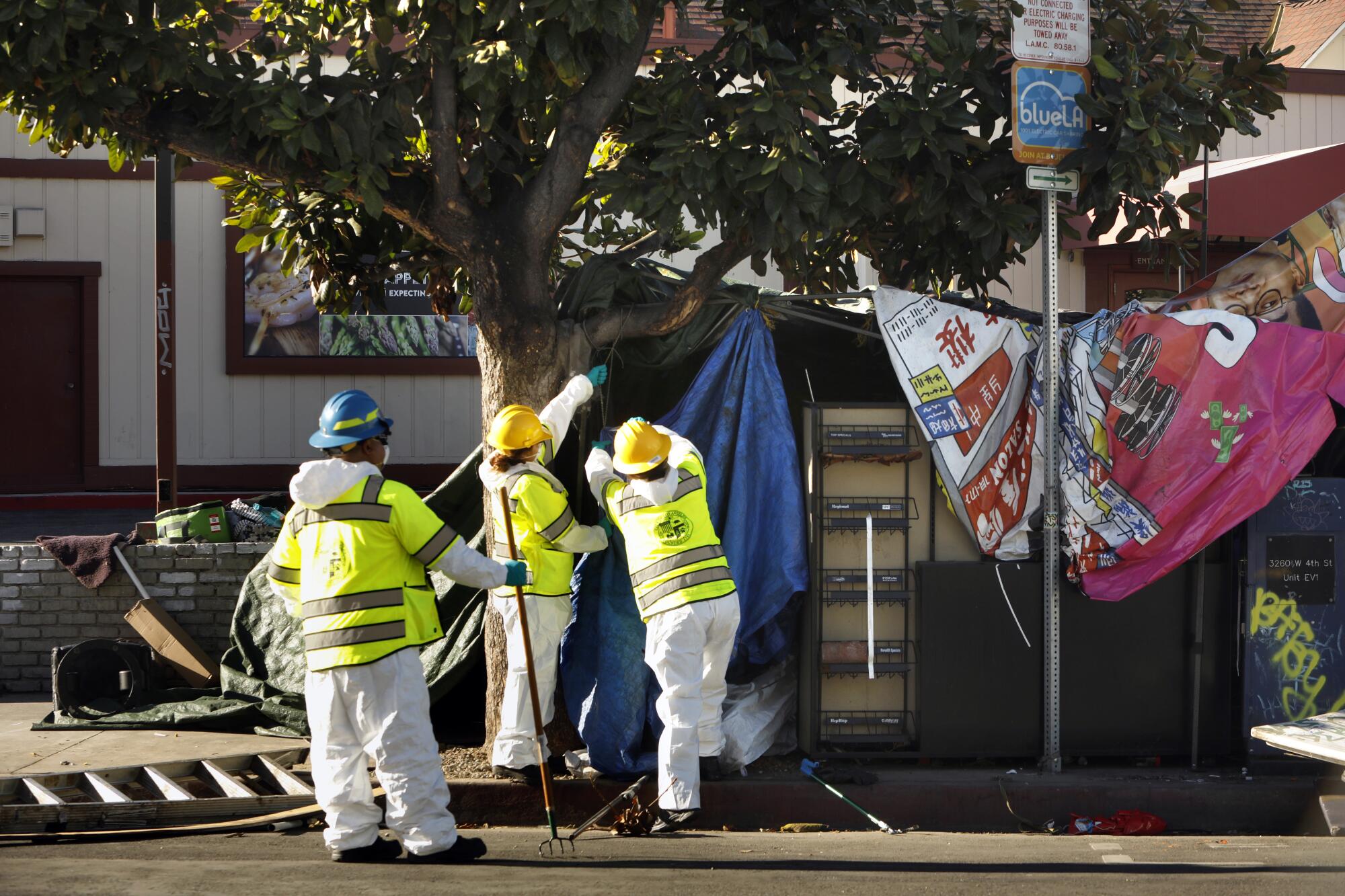
While decisively setting the city on a new course, the council actions are silent on key details such as how soon the closures will begin, how the rules will be enforced and what happens after shelter stays end.
How the new exclusion zones play out could vary considerably across the city, reflecting the number and size of camps and also the posture of individual council members.
Six council members have yet to propose any sites for camping restrictions, including Curren Price and Marqueece Harris-Dawson, whose South L.A. districts have some of the city’s largest encampments. Harris-Dawson’s office didn’t respond to repeated requests for comment.
Price’s spokeswoman, Angelina Valencia, said the councilman is considering restrictions along part of the 110 Freeway and near schools. She added that more people have been accepting offers of shelter since the city restarted its most intensive form of cleanups at encampments in September.
“Our shelter numbers have gone up, many at capacity,” she said.
Buscaino, who is running for mayor, said he intends to ask his colleagues to place his proposal on the June 2022 ballot, one where he also plans to appear as a candidate.
Mayor Eric Garcetti characterized the new focus on locations as a better balance between the needs of homeless people and the population at large. This balance, he said, was made possible by the expansion of outreach and services for homeless people, and the development of new housing and shelters funded by two local tax measures, city Proposition HHH and countywide Measure H.
“You don’t have to choose between these things,” Garcetti said in an interview.
“The liberation of public space and housing people is not an either/or. If you do it right, it’s both. We’ve showed that in the park settings so far.”
Councilman Kevin de León, who, like Buscaino, is among those vying to replace Garcetti next year, did not wait for council approval to start moving people from some of the six locations he has proposed clearing. De León used two motels in El Sereno purchased by the city with federal pandemic recovery funds and space at a downtown hotel leased by the city under a state program, Project Roomkey, to relocate everyone from extensive camps on Huntington Drive and Main Street. On Friday the council agreed to post signs and ban camping at the sites.
Project Roomkey, a state program backed by federal dollars, was intended to house homeless people during the pandemic. But it never got close to its goal.
The 21 sites approved in Councilman Bob Blumenfield’s west San Fernando Valley district included 12 underpasses along the 101 Freeway, of which only one, at Corbin Avenue, currently has an encampment. His office has been working with service providers for over a year to clear some freeway encampments, but he also included some locations simply for prevention.
Relocating people from the street to shelters provides a more stable environment to wait for that housing, Blumenfield argued. He also said his housed constituents need some certainty that they can use the sidewalk without stepping into oncoming traffic or go to the park without feeling unsafe.
“My thought is that the signs go up, and that folks don’t create encampments there,” Blumenfield said in an interview. “And then if they do, we will send outreach workers out there, and then the outreach workers are going to be the ones that say, ‘Hey, this area is off limits.’”
The job will be far more challenging in the Echo Park-to-Hollywood district of Councilman Mitch O’Farrell, whose 18 proposed locations all have at least one tent, and several are entrenched encampments half a block or longer. Nine of those sites were approved by the council on Tuesday.
Aaron Crandall, who has been living in one of those camps in Hollywood, said he was unaware of the proposed restrictions. Crandall said he would relocate if forced to but did not yet know where.
“Until then, I have to exist somewhere,” said the 49-year-old, who described himself as an unemployed flooring installer.
O’Farrell, who drew criticism this spring for what many saw as a heavy-handed and abrupt clearance of a large encampment at Echo Park, declined an interview request.
In a written statement, he said his office had been doing extensive outreach over the last year and created several hundred shelter beds and permanent housing units.
“There is nothing compassionate about enabling unhoused individuals to live or die in squalor on city sidewalks,” he said.
Over the summer, the City Council didn’t just institute new rules prohibiting homeless encampments. It drafted and approved a strategy that expands resources for outreach to homeless people and strives to ensure that those who are sleeping on the sidewalk aren’t forced to move without proper notice.
Though the new procedures have been drafted, and the city has created a checklist of actions that must occur before an encampment is cleared, no staff has been hired to carry them out.
The checklist includes a requirement that outreach workers “provide detailed documentation that a suitable offer of housing was made prior to enforcement,” according to city documents.
Even then, the city is supposed to wait 14 days while the outreach workers make sure people have another place to stay — even if it’s elsewhere on the street. Then the ordinance can be enforced.
It is unclear whether this process is being followed.
With this new law and the approach council members are taking, “Our work will be on the political front lines,” said PATH Executive Director Jennifer Hark Dietz — who runs the East Hollywood-based, statewide homeless services provider that has helped do outreach across the city. The banned locations cover so much of the city, she worries, there won’t be enough resources for outreach workers to adequately understand homeless people’s needs and get them shelter, medical care and housing.
Critics of the location-based strategy contend that it puts clean streets ahead of vulnerable people. They are also skeptical that the resources the City Council has asked for will materialize on a sufficient scale. They believe that if more resources are devoted to outreach and more interim and permanent housing is available, more people will move off the streets.
Councilman Mark Ridley-Thomas was central in the drafting of these street strategies. That was before he was indicted on charges of conspiracy, bribery and wire fraud, which he denies, and suspended by his colleagues.
A former USC dean is charged with paying off Mark Ridley-Thomas in exchange for millions of dollars in L.A. County contracts with the university.
Ridley-Thomas sent the City Council a letter last month expressing “deep concerns” about the path his colleagues were charting on homelessness. He said the outreach work that was supposed to accompany the anti-camping enforcement wasn’t occurring, and that without it, “all of the efforts to implement a balanced approach to address street homelessness will be for naught.”
Councilwoman Nithya Raman has charted her own course on street cleanups. Raman is seeking $3.8 million in city funds to concentrate outreach on 16 sites in her district, which stretches from Hancock Park to Sherman Oaks.
Unlike the nine other council members proposing location-based cleanups, Raman did not cite the new anti-camping law to prohibit camping. Instead, she set a goal to induce people to move voluntarily. Outreach teams would “navigate as many as 150 individuals — many of them chronically homeless — into shelter and connect them to permanent housing options.”
The new emphasis on cleaning locations couldn’t have happened without a surge in shelter capacity over the last three years that has changed the basic math of homeless outreach. The surge began with Garcetti’s 2018 launch of A Bridge Home, a shelter construction program that added space for about 2,100 people. The pandemic provided an unexpected windfall when the federal government provided funds for cities and counties to lease shuttered hotels and motels to get vulnerable people off the streets. The city currently has about 1,230 rooms under lease.
A third boost followed the partial settlement of a federal lawsuit filed by business and property owners alleging that the city and county had not fulfilled their obligation to keep the streets clean. The settlement, reached in 2020, committed the city to providing 6,000 new shelter beds for homeless people, and the judge in that lawsuit challenged council members individually to help homeless populations in their districts. The city spent about $73 million on this effort in fiscal year 2020-21.
The pressure led several council members to work with Garcetti to find vacant parcels where villages of shed-like tiny homes have sprung up. Tiny homes for up to 1,600 people are now either in use or under construction.
Much of the new shelter lay vacant because of pandemic spacing requirements, but now is gradually coming back into use, creating a rare moment when temporary shelter is much more widely available than it had been before.
The way that shelter is now being used — as the landing place for hundreds of people forced to leave street camps — is a departure from the practice developed over the past decade to sort out who should be prioritized for housing. Based on a numeric scale designed to rate a person’s acuity, or vulnerability to death if unhoused, the Coordinated Entry System assigns scarce housing subsidies to those with the highest scores.
A breakdown of acuity scores for those relocated to shelters from Venice shows that fewer than half would have been rated as high priority for housing.
Those who have invested years in that system say they are adapting to the change and do not see it as entirely contradictory.
“I don’t think the two approaches have to be confrontational or mutually exclusive,” said Heidi Marston, executive director of the Los Angeles Homeless Services Authority. “At the end of the day, our shelters are meant to ... be for people who want to be there, and then we work with you, no matter where you are, to get you your application for housing and moved along.”
The prioritization for housing became less critical, Marston said, when the agency received several thousand emergency housing vouchers through the federal pandemic recovery program. For the time being, at least, the greatest obstacle to housing is the dearth of available units in buildings that accept subsidized tenants.
Myers, the legal aid lawyer who represents an intervenor in the lawsuit, remains skeptical that housing will ever catch up to shelter. The rapid growth of shelter capacity has left the city with insufficient housing opportunities for every individual in a shelter. Myers said the ideal ratio would be five times the number of permanent housing spots as shelter beds. That doesn’t currently exist, she said.
The imbalance, she added, “just sinks the city’s resources into an interim shelter system, which itself still perpetuates homelessness.”
In addition, she said, many homeless people avoid congregate shelters, which they find dangerous and demeaning, and say they prefer life on the streets if they can’t have permanent housing or a temporary room that they don’t have to share.
The city’s tack toward removing camps was initially a response to public clamor over accumulations of tents in some of the city’s most prominent public spaces.
O’Farrell led the way with the controversial cleanup of Echo Park. After warning for months that the park would be closed, but not setting a deadline, he gave 24 hours’ notice that the park would be fenced off. Hundreds of police were called in to counter protesters outside the park. Dozens were arrested in a melee that followed.
There were housed residents who were grateful the park had been cleaned up and was safer. Few of the people who had been camping in the park have transitioned into permanent housing, though.
Of the 178 people who moved from Echo Park Lake into interim housing, 18 people have obtained rental subsidies for permanent housing and four people have gained permanent housing, according to data from the Los Angeles Homeless Services Authority. Data from the homeless services agency show that slightly fewer than half the people who were moved from Echo Park Lake are still in interim housing.
After a month of intensive outreach, most homeless campers have been removed from the Venice boardwalk and given shelter, if only temporarily.
Councilman Mike Bonin, who endured months of scathing community criticism before coordinating a cleanup of Venice Beach in early summer, got better results by a methodical approach backed by strong outreach.
With $5 million from the city’s pandemic recovery funds, Bonin brought in Venice-based St. Joseph Center for an all-hands-on-deck push. Dividing the half-mile-long encampment into five zones, St. Joseph‘s outreach teams persuaded 226 people to relocate to shelters. More than 180 of them have received housing subsidies, mainly through emergency pandemic vouchers, and 49 have found homes.
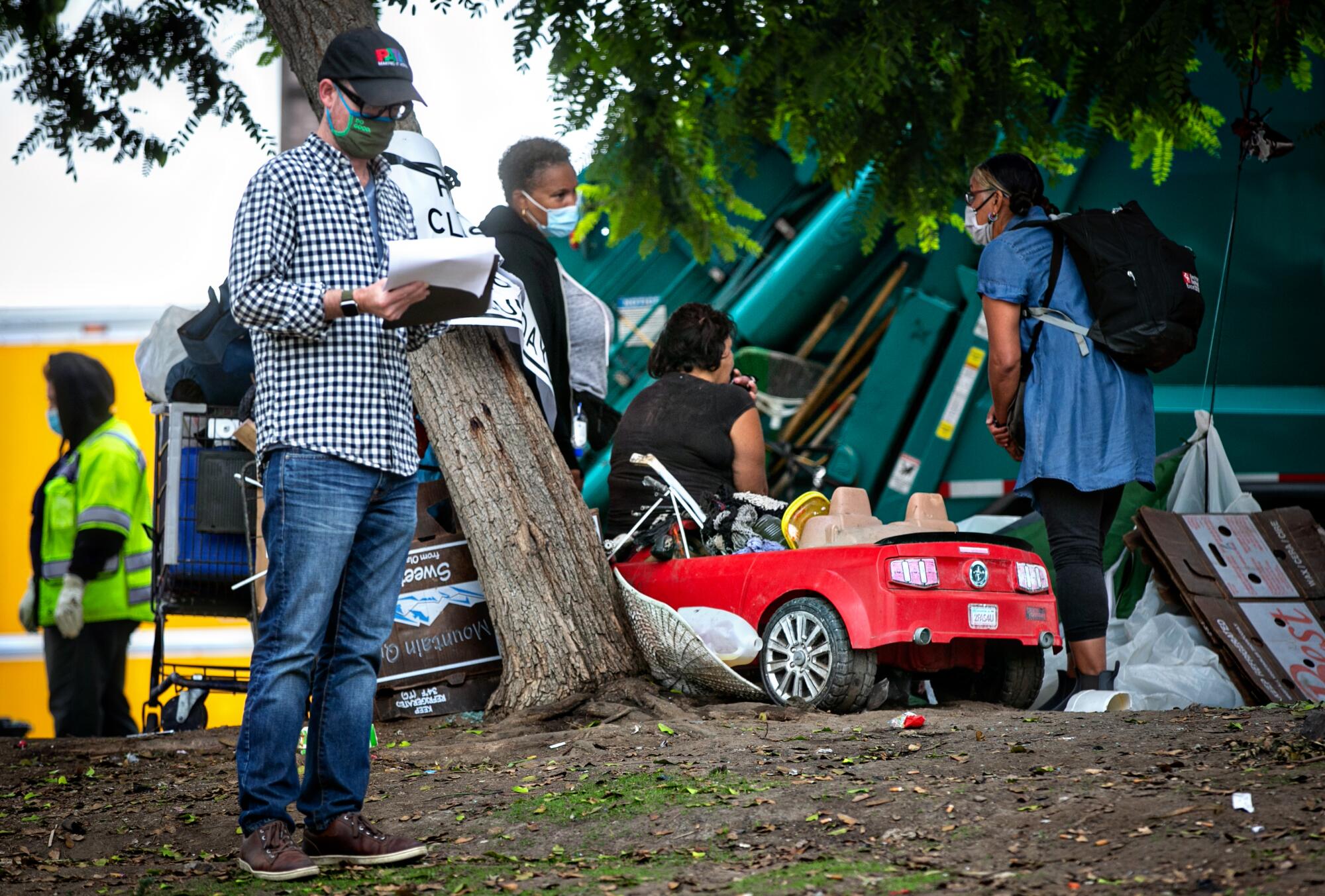
He has asked for and the City Council approved an additional $1.1 million to help get people living in Westchester Park into shelter.
Meanwhile, PATH, the East Hollywood-based, statewide homeless services provider, was proceeding with little fanfare in a slow-paced and gentle clearing of MacArthur Park, another signature L.A. landmark that had become dilapidated under heavy use in its densely populated Westlake neighborhood. The outreach began in January, partly motivated by concerns that the more than 200 people camping in the park were endangered by criminal gangs. Initially, there was no plan to close the park, PATH Executive Director Hark Dietz said.
But the success of the outreach allowed Councilman Gil Cedillo an opportunity to clear the southern portion of the park, south of Wilshire Boulevard, for renovation.
Over nine months, PATH relocated more than 200 people, leaving only a handful of tents in place when a two-week notice of the closure was announced in mid-October.
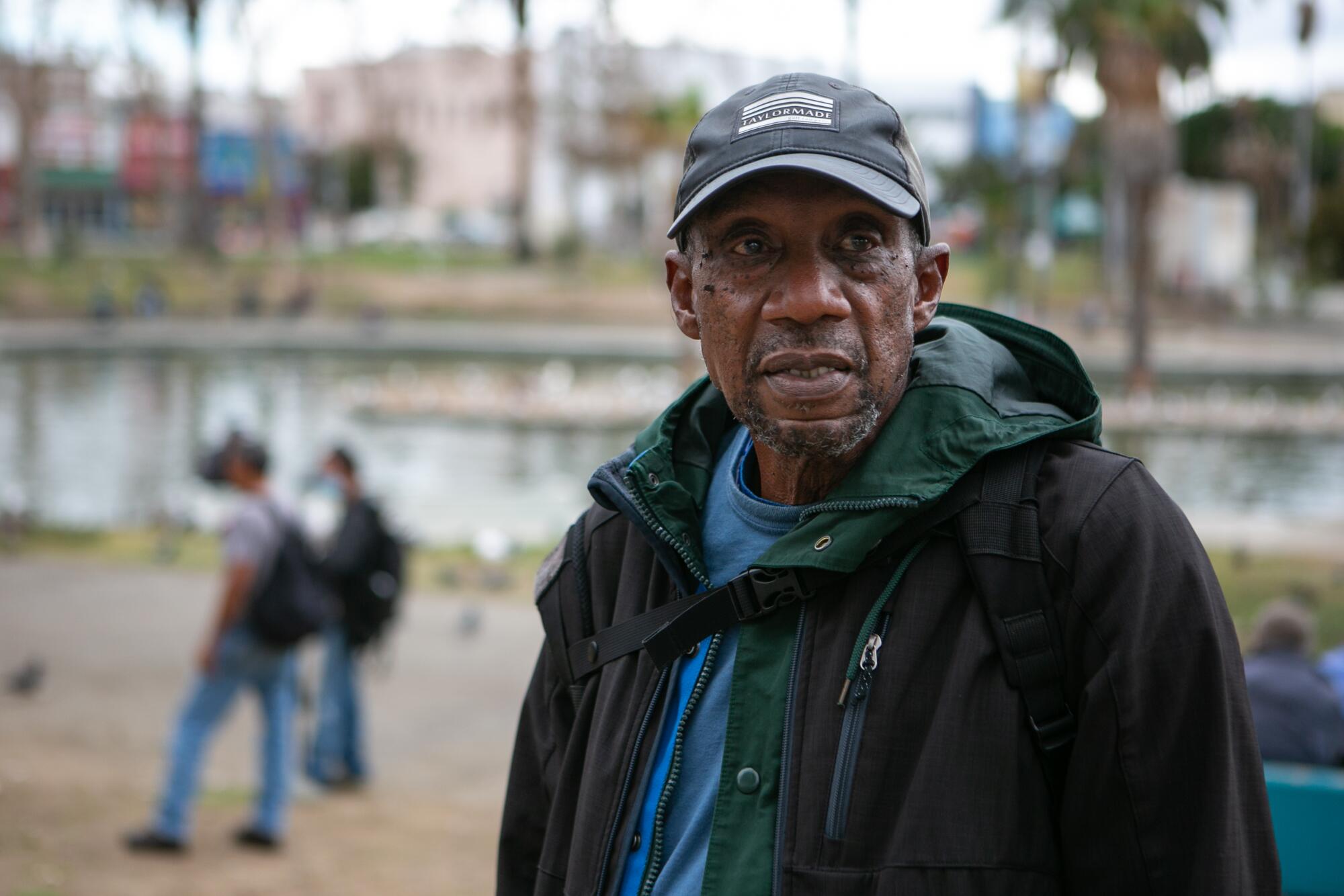
Outreach workers from various agencies organized on the park’s eastern edge. They were focusing on people who told them they had been living in the park. Some people living in nearby streets and alleys approached the workers to ask for help; they were told they would have to wait because the current focus was the park.
Ken Newkirk, 63, ambled over with a large blue bag full of his possessions. He’s been homeless on and off since 1985 and living in the park for six months. It had been hard on him. His tent was slashed and stolen at one point, and most days he went on long walks, turning over in his head how he ended up on the streets.
After speaking with an outreach worker from LAHSA, Newkirk’s face was brightened by the hot coffee a volunteer had handed him and the news he received.
“They’re going to do an assessment of me. Hopefully I go into a hotel today,” he said.
He’s now staying at a hotel nearby.
Times staff writer David Zahniser contributed to this report.
More to Read
Sign up for Essential California
The most important California stories and recommendations in your inbox every morning.
You may occasionally receive promotional content from the Los Angeles Times.
